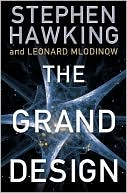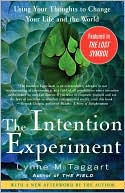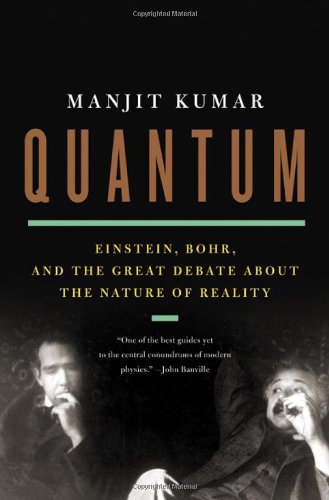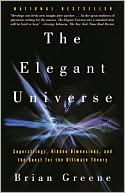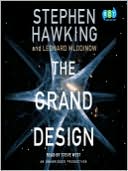Absolutely Small: How Quantum Theory Explains Our Everyday World
What gives objects their color? Why does copper conduct electricity, but glass does not? Why is carbon dioxide a greenhouse gas while oxygen and nitrogen are not? These are basic questions about how our world works that can't be answered with the usual explanations.\ Instead, we must turn to the fascinating field of quantum theory. Absolutely Small investigates the counterintuitive world of the tiniest particles on earth-photons, electrons, atoms, and molecules-that act nothing like objects...
Search in google:
What gives objects their color? Why does copper conduct electricity, but glass does not? Why is carbon dioxide a greenhouse gas while oxygen and nitrogen are not? These are basic questions about how our world works that can’t be answered with the usual explanations.Instead, we must turn to the fascinating field of quantum theory. Absolutely Small investigates the counterintuitive world of the tiniest particles on earth—photons, electrons, atoms, and molecules—that act nothing like objects in our human-sized world and actually upend conventional notions of physics.Absolutely Small opens up this extraordinary field to nonscientists, as it presents complex ideas without the complex equations. You’ll finally “get it” about quantum physics and quantum chemistry, now made accessible and understandable like never before—the math-drenched bestsellers of Stephen Hawking don’t even come close!Advance Praise for Absolutely Small“There are a few books that I always keep near at hand, and constantly come back to. The Feynman Lectures on Physics and Dirac’s classic textbook on quantum mechanics are among them. Michael Fayer’s wonderful new book, Absolutely Small, is about to join them. Whether you are a scientist or just curious about how the world works, this is the book for you.” — Leonard Susskind, Professor of Physics, Stanford University; author of The Black Hole War: My Battle With Stephen Hawking to Make the World Safe for Quantum Mechanics (Professor Susskind is widely regarded as one of the fathers of string theory.)“Absolutely Small by Professor Michael Fayer provides us with a clear way of visualizing the strange world of the quantum, and provides a deep understanding of many of its bizarre features; features that often on first encounter seem to defy our everyday experiences.”— Richard N. Zare, Professor in Natural Science at Stanford University; and Chairman, Department of Chemistry, Stanford University (Professor Zare is renowned for his research in the area of laser chemistry, resulting in a greater understanding of chemical reactions at the molecular level. He has received numerous honors and awards.)“Most lay readers think of the world of quantum mechanics as abstruse stuff accessible only to highly trained scientists. In this absolutely terrific book, Michael Fayer seemingly breaks one of the iron laws of science by making this material both lively and accessible.”— Richard A. Epstein, James Parker Hall Distinguished Service Professor of Law, The University of Chicago Publishers Weekly How a photon can be in two places at once is just one of the conundrums of quantum physics that Fayer (Elements of Quantum Mechanics) helps to unravel. The Stanford University Professor of Chemistry provides a roadmap for non-scientific readers who wish to understand the subject but lack advanced mathematical training. Fayer's belief that our everyday experiences "teach us to think in terms of classical physics" helps him easily breach the leap from playing ball to understanding how the earth orbits the sun. But because what we learn as children "prepares us to view nature in a manner that is fundamentally wrong," most people are at a loss when probing seemingly simple questions: "Why are cherries red and blueberries blue?" While the large objects treated in classical physics can be measured without appreciable disturbance, the same is not true at the quantum level. We may take the color and size of fruit for granted, but Fayer illustrates the ways in which "the natural world is driven by quantum phenomena" with a serious, accessible treatment of a complex and fascinating subject. (June)
Preface\ IF YOU ARE READING THIS, you probably fall into one of two broad\ categories of people. You may be one of my colleagues who is\ steeped in the mysteries of quantum theory and wants to see how\ someone writes a serious book on quantum theory with no math.\ Or, you may be one of the vast majority of people who look at the\ world around them without a clear view of why many things in\ everyday life are the way they are. These many things are not insignificant\ aspects of our environment that might be overlooked.\ Rather, they are important features of the world that are never explicated\ because they are seemingly beyond comprehension. What\ gives materials color, why does copper wire conduct electricity but\ glass doesn’t, what is a trans fat anyway, and why is carbon dioxide\ a greenhouse gas while oxygen and nitrogen aren’t? This lack of a\ picture of how things work arises from a seemingly insurmountable\ barrier to understanding. Usually that barrier is mathematics. To\ answer the questions posed above—and many more—requires an\ understanding of quantum theory, but it actually doesn’t require\ mathematics.\ This book will develop your quantum mechanics intuition,\ which will fundamentally change the way you view the world. You\ have an intuition for mechanics, but the mechanics you know is\ what we refer to as classical mechanics. When someone hits a long\ drive baseball, you know it goes up for a while, then the path turns\ over and the ball falls back to Earth. You know if the ball is hit\ harder, it takes off faster and will go farther before it hits the\ ground. Why does the ball behave this way? Because gravity is pulling\ it back to Earth. When you see the moon, you know it is orbiting\ the Earth. Why? Because gravity attracts the moon to the Earth. You\ don’t sit down and start solving Newton’s equations to calculate\ what is going on. You know from everyday experience that apples\ fall down not up and that if your car is going faster it will take\ longer to stop. However, you don’t know from everyday experience\ why cherries are red and blueberries are blue. Color is intrinsically\ dependent on the quantum mechanical description of molecules.\ Everyday experience does not prepare you to understand the nature\ of things around you that depend on quantum phenomena. As\ mentioned here and detailed in the book, understanding features of\ everyday life, such as color or electricity, requires a quantum theory\ view of nature\ Why no math? Imagine if this book contained discussions of a\ topic that started in English, jumped into Latin, then turned back to\ English. Then imagine that this jumping happened every time the\ details of an explanation were introduced. The language jumping is\ what occurs in books on quantum theory, except that instead of\ jumping from English to Latin, it jumps from English to math. In\ a hard core quantum mechanics book (for example, my own text,\ Elements of Quantum Mechanics [Oxford University Press, 2001]),\ you will find things like, ‘‘the interactions are described by the following\ set of coupled differential equations.’’ After the equations,\ the text reads, ‘‘the solutions are,’’ and more equations appear. In\ contrast, the presentation in this book is descriptive. Diagrams replace\ the many equations, with the exception of some small algebraic\ equations—and these simple equations are explained in detail.\ Even without the usual overflow of math, the fundamental philosophical\ and conceptual basis for and applications of quantum theory\ are thoroughly developed. Therefore, anyone can come away\ with an understanding of quantum theory and a deeper understanding\ of the world around us. If you know a good deal of math, this\ book is still appropriate. You will acquire the conceptual understanding\ necessary to move on to a mathematical presentation of\ quantum theory. If you are willing to do some mental gymnastics,\ but no math, this book will provide you with the fundamentals of\ quantum theory, with applications to atomic and molecular matter.
Preface viiChapter 1 Schrödinger's Cat 1Chapter 2 Size Is Absolute 8Chapter 3 Some Things About Waves 22Chapter 4 The Photoelectric Effect and Einstein's Explanation 36Chapter 5 Light: Waves or Particles? 46Chapter 6 How Big Is a Photon and the Heisenberg Uncertainty Principle 57Chapter 7 Photons, Electrons, and Baseballs 80Chapter 8 Quantum Racquetball and the Color of Fruit 96Chapter 9 The Hydrogen Atom: The History 118Chapter 10 The Hydrogen Atom: Quantum Theory 130Chapter 11 Many Electron Atoms and the Periodic Table of Elements 151Chapter 12 The Hydrogen Molecule and the Covalent Bond 178Chapter 13 What Holds Atoms Together: Diatomic Molecules 196Chapter 14 Bigger Molecules: The Shapes of Polyatomic Molecules 221Chapter 15 Beer and Soap 250Chapter 16 Fat, It's All About the Double Bonds 272Chapter 17 Greenhouse Gases 295Chapter 18 Aromatic Molecules 314Chapter 19 Metals, Insulators, and Semiconductors 329Chapter 20 Think Quantum 349Glossary 363Index 375
\ Publishers WeeklyHow a photon can be in two places at once is just one of the conundrums of quantum physics that Fayer (Elements of Quantum Mechanics) helps to unravel. The Stanford University Professor of Chemistry provides a roadmap for non-scientific readers who wish to understand the subject but lack advanced mathematical training. Fayer's belief that our everyday experiences "teach us to think in terms of classical physics" helps him easily breach the leap from playing ball to understanding how the earth orbits the sun. But because what we learn as children "prepares us to view nature in a manner that is fundamentally wrong," most people are at a loss when probing seemingly simple questions: "Why are cherries red and blueberries blue?" While the large objects treated in classical physics can be measured without appreciable disturbance, the same is not true at the quantum level. We may take the color and size of fruit for granted, but Fayer illustrates the ways in which "the natural world is driven by quantum phenomena" with a serious, accessible treatment of a complex and fascinating subject. (June)\ \ \ \ \ From the Publisher“…appeal to anyone with a curious mind who has ever wondered what all the quantum mechanics fuss is about, and to those who simply want to understand the everyday world."-- ForeWord\ "... illustrates the ways in which 'the natural world is driven by quantum phenomena' with a serious, accessible treatment of a complex and fascinating subject." --Publishers Weekly\ “Favouring everyday examples over formulae, he makes quantum mechanics palatable, from wave–particle duality to the uncertainty principle… book provides a useful overview.” – Nature magazine\ “From why everyday mysteries have quantum roots to how to understand quantum mechanics without the math… an invaluable guide…” -- The Midwest Book Review\ "Finally, someone caught up with the importance of explaining Quantum Theory in layman’s terms…Fayer does a marvelous job at uniting the various aspects of matter and energy.” -- Sacramento Book Review\ “…one of the most intriguing books about quantum science currently on the market…must-read for those who want to learn more about quantum theory.”--NSTA Recommends\ "...lively with amusing and useful examples, analogies, and descriptions of scientists and experiments...introduce nonscientists to quantum mechanics...useful for advanced graduate students and professional scientists...Highly recommended." --Choice\ \ \

